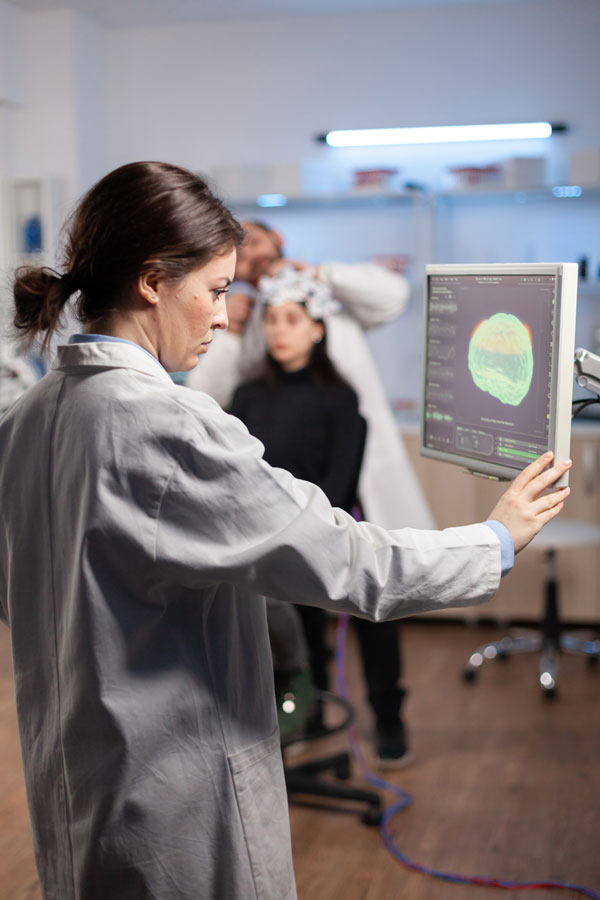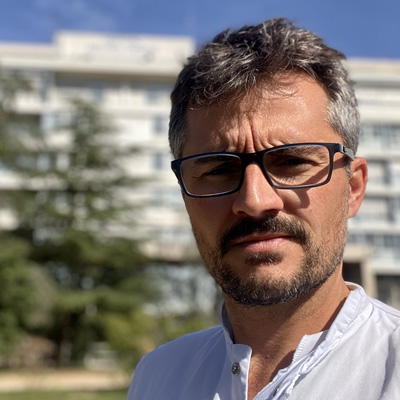Dr GOBERT, Florent
Evaluation des troubles de la conscience
L’équipe d’anesthésie-réanimation de l’hôpital neurologique intervient lors des 4500 interventions réalisées chaque année par les chirurgiens et les radiologues de l’établissement. Elle prend en charge plus de 1600 séjours/an de réanimation ou de soins post-interventionnels. Spécialisée, elle prend en charge également les traitements par plasmaphérèse des patients souffrant de pathologies dysimmunitaires chroniques.


Projet
Axes de recherche
Les liens avec d’autres équipes nationales ou internationales
Publications
1. Twenty-four-hour rhythmicities in disorders of consciousness are associated with a favourable outcome.
Gobert F, Corneyllie A, Bastuji H, Berthomier Ch, Thevenet M, Abernot J, Raverot V, Dailler F, Guérin C, Gronfier C, Luauté J, and Perrin F (2023).
Communications Biology — Résumé
Fluctuations of consciousness and their rhythmicities have been rarely studied in patients
with a disorder of consciousness after acute brain injuries. 24-h assessment of brain (EEG),
behaviour (eye-opening), and circadian (clock-controlled hormones secretion from urine)
functions was performed in acute brain-injured patients. The distribution, long-term predictability,
and rhythmicity (circadian/ultradian) of various EEG features were compared with
the initial clinical status, the functional outcome, and the circadian rhythmicities of behaviour
and clock-controlled hormones. Here we show that more physiological and favourable patterns
of fluctuations are associated with a higher 24 h predictability and sharp up-and-down
shape of EEG switches, reminiscent of the Flip-Flop model of sleep. Multimodal rhythmic
analysis shows that patients with simultaneous circadian rhythmicity for brain, behaviour, and
hormones had a favourable outcome. Finally, both re-emerging EEG fluctuations and
homogeneous 24-h cycles for EEG, eye-opening, and hormones appeared as surrogates for
preserved functionality in brainstem and basal forebrain, which are key prognostic factors for
later improvement. While the recovery of consciousness has previously been related to a high
short-term complexity, we suggest in this exploratory study the importance of the high
predictability of the 24 h long-term generation of brain rhythms and highlight the importance
of circadian body-brain rhythms in awakening.
2. Infraclinical detection of voluntary attention in coma and post-coma patients using electrophysiology.
Morlet D, Mattout J, Fischer C, Luaute J, Dailler F, Ruby, Andre-Obadia N. (2023)
Clin Neurophysiol. — Résumé
Objective: Early functional evaluation and prognosis of patients with disorders of consciousness is a major challenge that clinical assessments alone cannot solve. Objective measures of brain activity could help resolve this uncertainty. We used electroencephalogram at bedside to detect voluntary attention with a paradigm previously validated in healthy subjects.
Methods: Using auditory-oddball sequences, our approach rests on detecting known attentional modulations of Event Related Potentials that reflect compliance with verbal instructions. Sixty-eight unresponsive patients were tested in their first year after coma onset (37 coma and 31 first year post-coma patients). Their evolution 6 months after the test was considered.
Results: Fourteen of the 68 patients, showed a positive response. Nine were in a coma and 5 in a minimally conscious state (MCS). Except for one who died early, all responders evolved to exit-MCS within 6 months (93%), while 35 (65%) among non-responders only.
Conclusions: Among those patients for whom the outcome is highly uncertain, 21% responded positively to this simple but cognitively demanding test. Strikingly, some coma patients were among responders.
Significance: The proposed paradigm revealed cognitive-motor dissociation in some coma patients. This ability to sustain attention on demand predicted awakening within 6 months and represents an immediately useful information for relatives and caregivers.
Keywords: Active paradigm; Coma; Consciousness disorders; Electroencephalography; Event related potentials; Outcome.
3. Virtually spatialized sounds enhance auditory processing in healthy participants and patients with a disorder of consciousness.
Heine L, Corneyllie A, Gobert F, Luauté J, Lavandier M, Perrin F (2021)
Scientific Reports — Résumé
Neuroscientific and clinical studies on auditory perception often use headphones to limit sound interference. In these conditions, sounds are perceived as internalized because they lack the sound-attributes that normally occur with a sound produced from a point in space around the listener. Without the spatial attention mechanisms that occur with localized sounds, auditory functional assessments could thus be underestimated. We hypothesize that adding virtually externalization and localization cues to sounds through headphones enhance sound discrimination in both healthy participants and patients with a disorder of consciousness (DOC). Hd-EEG was analyzed in 14 healthy participants and 18 patients while they listened to self-relevant and irrelevant stimuli in two forms: diotic (classic sound presentation with an “internalized” feeling) and convolved with a binaural room impulse response (to create an “externalized” feeling). Convolution enhanced the brains’ discriminative response as well as the processing of irrelevant sounds itself, in both healthy participants and DOC patients. For the healthy participants, these effects could be associated with enhanced activation of both the dorsal (where/how) and ventral (what) auditory streams, suggesting that spatial attributes support speech discrimination. Thus, virtually spatialized sounds might “call attention to the outside world” and improve the sensitivity of assessment of brain function in DOC patients.
4. Do not rely on imaging to predict awakening: The value of neurophysiology in a case of Weston-Hurst syndrome.
Gobert F, Ritzenthaler T, Dailler F (2019).
Clin Neurophysiol . — Résumé
No abstract available
5. Is circadian rhythmicity a prerequisite to coma recovery? Circadian recovery concomitant to cognitive improvement in two comatose patients.
Gobert F, Luauté J, Raverot V, Cotton F, Dailler F, Claustrat B, Perrin F* and Gronfier C* (2019)
J Pineal Res, — Résumé
Circadian rhythmicity (CR) is involved in the regulation of all integrated functions, from sleep-wake cycle regulation to metabolic function, mood and cognition. However, the interdependence of CR, cognition and consciousness has been poorly addressed. To clarify the state of CR in coma and to determine the chronological relationship between its recovery and consciousness after brain lesions, we conducted a longitudinal observational study investigating how the state of CR was chronologically related with the recovery of behavioural wakefulness, cognition and/or awareness. Among 16 acute comatose patients, we recruited two 37-year-old patients with a persistent disorder of consciousness, presenting diencephalic lesions caused by severe traumatic brain injuries. Two biological urinary markers of CR were explored every 2 hours during 24 hours (6-sulfatoxymelatonin, free cortisol) with a dedicated methodology to extract the endogenous component of rhythmicity (environmental light recording, near-constant-routine protocol, control of beta-blockers). They presented an initial absence of rhythmic secretions and a recovered CR 7-8 months later. This recovery was not associated with the restoration of behavioural wakefulness, but with an improvement of cognition and awareness (up to the minimally conscious state). MRI showed a lesion pattern compatible with the interruption of either the main hypothalamic-sympathetic pathway or the accessory habenular pathway. These results suggest that CR may be a prerequisite for coma recovery with a potential but still unproven favourable effect on brain function of the resorted circadian melatonin secretion and/or the functional recovery of the suprachiasmatic nucleus (SCN). Assessing circadian functions by urinary melatonin should be further explored as a biomarker of cognition reappearance and investigated to prognosticate functional recovery.
6. Restoring consciousness with vagus nerve stimulation.
Corazzol M, Lio G, Lefevre A, Deiana G, Tell L, Andre-Obadia N, Bourdillon P, Guenot M, Desmurget M, Luaute J, Sirigu A (2017)
Curr Biol. — Résumé
Patients lying in a vegetative state present severe impairments of consciousness [1] caused by lesions in the cortex, the brainstem, the thalamus and the white matter [2]. There is agreement that this condition may involve disconnections in long-range cortico-cortical and thalamo-cortical pathways [3]. Hence, in the vegetative state cortical activity is ‘deafferented’ from subcortical modulation and/or principally disrupted between fronto-parietal regions. Some patients in a vegetative state recover while others persistently remain in such a state. The neural signature of spontaneous recovery is linked to increased thalamo-cortical activity and improved fronto-parietal functional connectivity [3]. The likelihood of consciousness recovery depends on the extent of brain damage and patients’ etiology, but after one year of unresponsive behavior, chances become low [1]. There is thus a need to explore novel ways of repairing lost consciousness. Here we report beneficial effects of vagus nerve stimulation on consciousness level of a single patient in a vegetative state, including improved behavioral responsiveness and enhanced brain connectivity patterns.
7. Proving cortical death after vascular coma: Confrontation of evoked potentials, EEG and radiology. Clin Neurophysiol. Mar 17;129(6):1105-1116
Gobert F, Dailler F, Fischer C, André-Obadia N and Luauté J (2018)
Clin Neurophysiol — Résumé
Pas de résumé
8. Diagnosing Kernohan-Woltman notch phenomenon by Somatosensory Evoked Potentials in ICU. Clin Neurophysiol. 2018 Jan;129(1):254-257. doi: 10.1016/j.clinph.2017.11.009. Epub 2017 Nov 22.
Gobert F, Baars J, Ritzenthaler T, Afathi M, Boulogne S, André-Obadia N and Dailler F (2017)
Clin Neurophysiol — Résumé
Pas de résumé
9. Buying time to save a life: A 3-month “call in the dark for awareness”. A moral dilemma in predicting consciousness recovery.
Gobert F, Le Cam P, Guérin C (2016)
Intensive Care Med. — Résumé
No abstract available
10. Long-term outcomes of chronic minimally conscious and vegetative states.
Luaute J, Maucort-Boulch D, Tell L, Quelard F, Sarraf T, Iwaz J, Boisson D, Fischer C (2010).
Neurology — Résumé
Objective: The present retrospective cohort study compares the long-term functional outcome, improvement or deterioration, of patients considered in a vegetative state (VS) or a minimally conscious state (MCS) 1 year after coma onset, then yearly for up to 5 years.
Methods: We reviewed the clinical courses of 12 patients in VS and 39 in MCS. The outcomes were assessed at 2, 3, 4, and 5 years after injury using the 5 categories of the Glasgow Outcome Scale plus an additional category for patients in MCS. A logistic regression analysis investigated the relationships between each outcome and 10 predictor variables. Four of these variables were auditory evoked potentials recorded at the early stage of coma.
Results: None of the patients in VS improved during the follow-up period: 1 was lost to follow-up, 9 died, and 2 remained in VS. Among patients in MCS, 3 were lost to follow-up, 14 died, 9 remained in MCS, and 13 emerged from MCS with severe disabilities. VS, age >39 years, and bilateral absence of cortical components of middle-latency auditory evoked potentials were significantly associated with deterioration.
Conclusions: In contrast to patients in VS, a third of patients in MCS improved more than 1 year after coma onset. This emphasizes the need to define reliable boundaries between VS and MCS using repeated clinical evaluations and all imaging and neurophysiologic tools available today.

